Parameter Quantification
Electronic Poster
Acquisition, Reconstruction & Analysis
Thursday, 21 June 2018
| Exhibition Hall |
14:15 - 15:15 |
| |
|
Computer # |
|
5628.
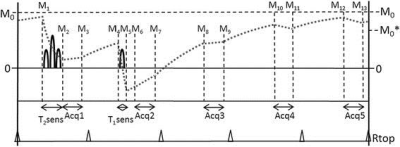 |
97 |
 3D multi-parameter mapping of the breast with Dixon fat-water separation 3D multi-parameter mapping of the breast with Dixon fat-water separation
Ken-Pin Hwang, Jong Bum Son, Suchandrima Banerjee, Tao Zhang, Jingfei Ma, Gaiane Rauch, Marcel Warntjes
3D QALAS is a promising new technique that simultaneously maps T1, T2, and PD in a single 3D acquisition. However, the presence of fat can confound multi-parameter mapping of voxels with mixed species. We modified the sequence to acquire dualecho readouts and apply a joint field map estimation across all echoes to produce water-only images for multi-parameter fitting. The technique was applied in the breast and parameter maps were compared with those generated from a 2D unsuppressed acquisition. By eliminating partial volume effects of fat, the technique potentially extends the use of 3D multi-parameter mapping into body, breast, and spine.
|
|
5629.
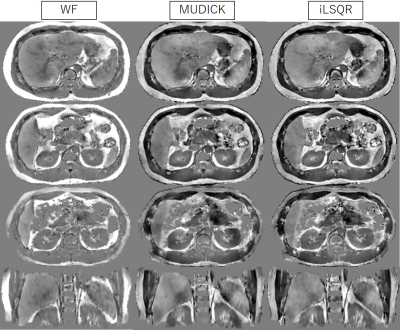 |
98 |
 Comparison of reconstruction algorithms for quantitative susceptibility mapping in the upper abdomen Comparison of reconstruction algorithms for quantitative susceptibility mapping in the upper abdomen
Taisuke Harada, Kohsuke Kudo, Ryota Sato, Masato Yoshikawa, Satoshi Yabusaki, Toru Shirai, Yoshitaka Bito
We compared three QSM reconstruction algorithms for use in the upper abdomen: the water-fat separation method (WF), MUDICK, and iLSQR. A healthy male was scanned nine times, in different positions, and three QSM reconstructions from the same source data were compared. The intra-scan SD, representing image homogeneity among images, and the inter-scan SD, representing repeatability among scans, were lower in WF than in MUDICK and iLSQR. Thus, the WF method yielded better homogeneity and repeatability for susceptibility values in the upper abdomen. This forms the basis for further clinical studies and applications of QSM in the abdomen.
|
|
5630.
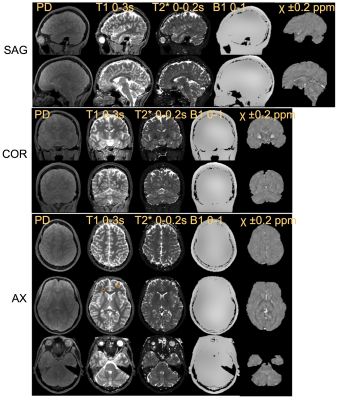 |
99 |
 Fast 3D Multi-Parameter Mapping of Relaxation Times and Susceptibility Using Partially RF-Spoiled Gradient Echo at 3T Fast 3D Multi-Parameter Mapping of Relaxation Times and Susceptibility Using Partially RF-Spoiled Gradient Echo at 3T
Yo Taniguchi, Suguru Yokosawa, Toru Shiraii, Ryota Sato, Tomoki Amemiya, Hisaaki Ochi, Yoshihisa Soutome
A method is presented to simultaneously quantify multiple tissue parameters, including susceptibility, by using a partially RF-spoiled gradient echo sequence. The method successfully obtained whole-brain T1, T2*, PD, B1, and susceptibility maps in 1.1-mm isotropic resolution in 12 minutes at 3T. T1, T2*, PD, and B1 maps were estimated simultaneously by a least-squares fit using twelve 3D source images. The intensity function for the fit was formulated by Bloch simulations. Scan parameters were optimized for T1 and T2* values of the brain at 3T. The susceptibility map was estimated by using six multi-echo images in the source images.
|
|
5631.
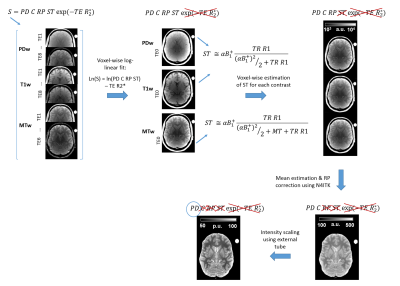 |
100 |
Robust PD mapping using multi-contrast variable flip angle (VFA) data
Video Permission Withheld
Sara Lorio, Tim Tierney, Amy McDowell, Owen Arthurs, Antoine Lutti, Nikolaus Weiskopf, David Carmichael
Proton density (PD) maps measure the amount of free water molecules in the tissue and can be used in a range of neurological disorders. However, current PD estimation methods in the brain rely on anatomical prior information which can be problematic in the case of severe tissue abnormalities. Here we propose a new approach for PD mapping based on a multi-contrast acquisition protocol, and a data-driven estimation method for inhomogeneity correction and map scaling. This approach can be applied on ex-vivo samples and in case of pronounced brain pathology because it does not require any anatomical nor tissue information.
|
|
5632.
 |
101 |
Validation of a quantitative susceptibility mapping acquisition and reconstruction pipeline using a new iron sucrose based MR susceptibility phantom.
Jeremy Deverdun, Francois Molino, Nicolas Menjot de Champfleur, Emmanuelle Le Bars
Quantitative susceptibility mapping (QSM) is a new technique, and it has been shown that results can vary according to the MRI device, phase reconstruction, and susceptibility estimation algorithms. Porting this mapping on the clinical practice would be of interest in numerous kind of pathology. However, it requires a validation which should be performed using a dedicated MR phantom. We described an easy to build MR susceptibility phantom based on iron sucrose. Using optimal parameters, the quantitative susceptibility mapping provides a very good estimation of the iron concentrations in the phantom.
|
|
5633.
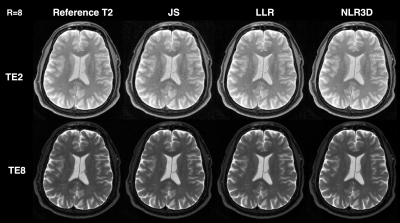 |
102 |
 Higher-order subspace denoising for improved multi-contrast imaging and parameter mapping Higher-order subspace denoising for improved multi-contrast imaging and parameter mapping
Sagar Mandava, Mahesh Keerthivasan, Diego Martin, Maria Altbach, Ali Bilgin
Multi-contrast image acquisitions are valuable for diagnostics but the scan time scales with the number of contrast images. Accelerated acquisitions are necessary for practical scan times and require the use of constrained reconstructions. Subspace-constraints, which constrain the multi-contrast data to lie in a low-dimensional subspace, are popularly used to reconstruct these datasets. Despite yielding good quality images at most imaging contrasts, these constraints create poor image quality at certain contrasts. We demonstrate that this is due to poor recovery of higher order subspace coefficients and present a model to enable high quality recovery of these coefficients and consequently the echo-images.
|
|
5634.
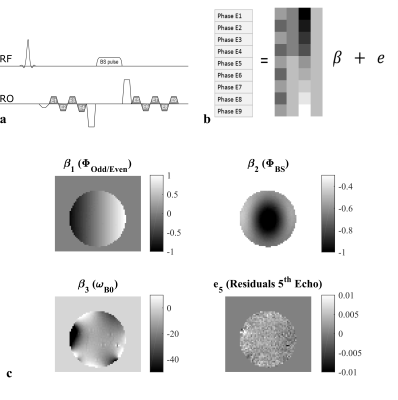 |
103 |
 Rapid B1 mapping based on the Bloch-Siegert shift using a single offset frequency and multi-echo readout Rapid B1 mapping based on the Bloch-Siegert shift using a single offset frequency and multi-echo readout
Nadège Corbin, Julio Acosta-Cabronero, Oliver Josephs, Nikolaus Weiskopf, Martina Callaghan
The advance towards in vivo histology benefits greatly from the quantification of specific physical parameters1. The longitudinal relaxation rate (R1) has proven a reliable surrogate for myelination, facilitating investigation of the relationship between brain microstructure and function in vivo2–5. R1maps can be estimated by combining spoiled gradient-echo volumes, acquired with variable flip angles, and calibration data correcting for flip angle inhomogeneities. The Bloch-Siegert shift (BSS) approach6 is a relatively time-efficient method that allows the calibration data to be acquired with an identical gradient-echo readout thereby matching distortions across all data needed to map R1. However, it requires data to be acquired at two off-resonance frequencies to remove B0 dependence up to second order and suffers from high specific-absorption-rate (SAR). Here, we investigate a modified BSS-based B1+ mapping approach that aimed to overcome these shortcomings by using a single offset frequency and a multi-echo readout.
|
|
5635.
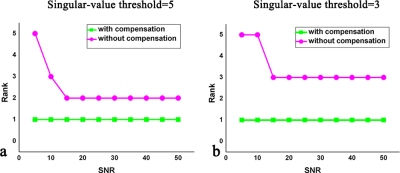 |
104 |
 SCOPE-T1?: Signal Compensation for Low-rank Plus Sparse Matrix Decomposition for Fast T1? Mapping SCOPE-T1?: Signal Compensation for Low-rank Plus Sparse Matrix Decomposition for Fast T1? Mapping
Yuanyuan Liu, Yanjie Zhu, Leslie Ying, Yi-Xiang J Wang, Jing Yuan, Xin Liu, Dong Liang
Quantitative T1ρ mapping typically requires the acquisition of multiple images with different spin-lock times, which greatly prolongs the scanning time, limiting its clinical applications. We developed a novel reconstruction method using a low-rank plus sparse model to obtain the parameter-weighted images from highly undersampled k-space data. This method exploited both the parameter-weighted image properties and priori information from the parameter model. Specifically, a signal compensation strategy was introduced to promote the low rankness along the parametric direction. The proposed method achieved a five-fold acceleration in the acquisition time and obtained more accurate T1ρ maps than the existing methods.
|
|
5636.
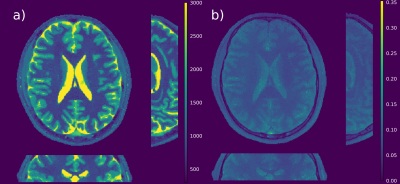 |
105 |
 High Resolution T1 quantification from golden-angle radial 3D acquisitions. High Resolution T1 quantification from golden-angle radial 3D acquisitions.
Oliver Maier, Matthias Schloegl, Jasper Schoormans, Bram Coolen, Tobias Block, Thomas Benkert, Gustav Strijkers, Rudolf Stollberger
A model-based reconstruction approach is presented that allows time efficient encoding of radial data for high resolution 3D T1 quantification e.g. (256x256x52, 1mm3, tscan=96s) by exploiting structural similarities in 3D and between different parameter maps. The proposed method employs a 3D TGV-Frobenius regularization to achieve high quality parameter maps from 3D VFA and 3D IRLL data. A dedicated reconstruction framework, consisting of an iteratively-regularized Gauss-Newton algorithm combined with a Primal-Dual splitting is employed to solve the optimization problem. Reconstructed parameter maps exhibit high SNR and no residual streaking artifacts while reconstructed T1 values agree well with reported values from literature.
|
|
5637.
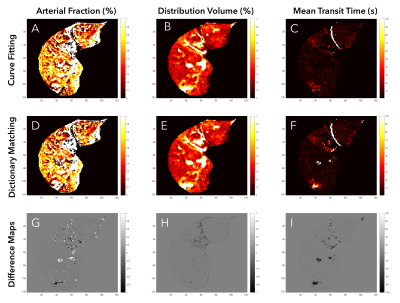 |
106 |
 Quantifying Perfusion Properties with DCE-MRI Using a Dictionary Matching Approach Quantifying Perfusion Properties with DCE-MRI Using a Dictionary Matching Approach
Satyam Ghodasara, Sam Frankel, Yong Chen, Mark Griswold, Nicole Seiberlich, Vikas Gulani, Katherine Wright
To overcome the shortcomings of curve fitting to quantify perfusion properties, a dictionary matching approach like that used in magnetic resonance fingerprinting is proposed. This dictionary matching approach could be used for any DCE application or model, but is demonstrated and validated here for a dual-input single-compartment model of liver DCE-MRI data. The dictionary matching method provides similar results to the curve fitting method while being simpler to implement and dramatically faster.
|
|
5638.
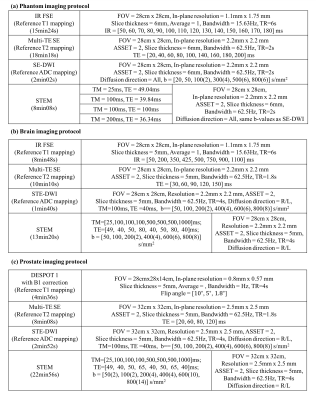 |
107 |
 STimulated Echo based Mapping (STEM) of T1, T2 and Apparent Diffusion Coefficient STimulated Echo based Mapping (STEM) of T1, T2 and Apparent Diffusion Coefficient
Yuxin Zhang, Xiaoke Wang, Valentina Taviani, Diego Hernando
This study proposed an approach for joint estimation of T1 and T2 relaxation as well as quantitative diffusion parameters. The proposed approach has been evaluated in quantitative relaxation-diffusion phantom, in-vivo brain imaging and prostate imaging. The overall T1, T2 and ADC measurements have been shown to be accurate compared to reference maps. In this feasibility study, the acquisition was over-sampled in TM-TE-b space, which limited the scan time. Future work will introduce undersampling and protocol optimization. In summary, this method has the potential to enable multi-dimensional tissue characterization in clinically feasible acquisition times.
|
|
5639.
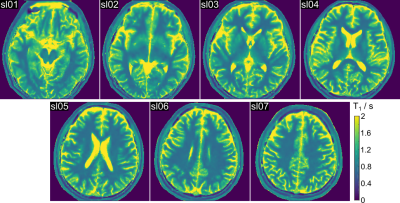 |
108 |
 Single-shot multi-slice T1 mapping using inversion recovery radial FLASH and model-based reconstruction Single-shot multi-slice T1 mapping using inversion recovery radial FLASH and model-based reconstruction
Xiaoqing Wang, Dirk Voit, Volkert Roeloffs, Martin Uecker, Jens Frahm
Fast quantitative T1 mapping can be achieved within a single inversion recovery based on recent advances in real-time MRI and/or model-based reconstructions. However, efforts have been mainly focused on single-slice T1 mapping. To further take advantage of inherent data redundancy, we propose a single-shot high-resolution multi-slice T1 mapping technique which bases on a spoke-interleaved radial FLASH data acquisition scheme and a recent proposed model-based reconstruction technique. Initial results show that we could achieve high resolution seven-slice human brain T1 maps or three-slice abdominal T1 maps within 4 seconds.
|
|
5640.
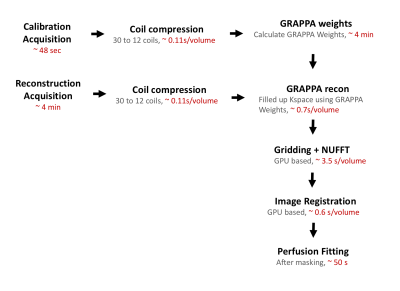 |
109 |
 Online Free-Breathing Liver Perfusion Imaging Using Parallel Computing and the Gadgetron Framework Online Free-Breathing Liver Perfusion Imaging Using Parallel Computing and the Gadgetron Framework
Kun Yang, Yong Chen, Satyam Ghodasara, Wei-Ching Lo, Yun Jiang, Nicole Seiberlich, Katherine Wright, Vikas Gulani
Accelerated image acquisition, advanced reconstruction and registration methods, and perfusion modeling have recently enabled free-breathing and quantitative 4D DCE MRI in the liver. However, the reconstruction, registration and model fitting steps are performed offline as they are time consuming; each data set takes more than a day to analyze. This makes quantitative 3D liver perfusion unsuitable for clinical deployment. We propose using a GPU-based Gadgetron framework for parallelized and near-immediate provision of all data, including a Spiral GRAPPA reconstruction, non-rigid image registration, and pharmacokinetic modeling using a dictionary-based approach. This approach reduces the reconstruction time from hours to minutes.
|
|
5641.
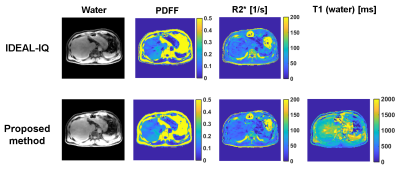 |
110 |
 Simultaneous mapping of R2*, T1, and proton density fat fraction for the liver: single breath-hold acquisition with multi-echo spoiled gradient echo and compressed sensing Simultaneous mapping of R2*, T1, and proton density fat fraction for the liver: single breath-hold acquisition with multi-echo spoiled gradient echo and compressed sensing
Daiki Tamada, Tetsuya Wakayama, Utaroh Motosugi, Hiroshi Onishi
In this study, we developed multi-parameter mapping including T1, R2*, and proton density fat fraction with a single breath-hold, to evaluate liver disease and liver function. Six-echo spoiled gradient echo sequence with dual flip angles was used to acquire a 12-set MRI volume dataset. To shorten the scan time, undersampling and multi-contrast compressed sensing reconstruction were used. Quantitative values were validated by performing phantom and volunteer studies.
|
|
5642.
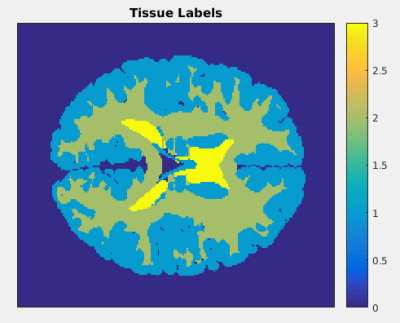 |
111 |
Information Theory Quantification of Acquisition Parameter Impact on Synthetic MRI Reconstruction Uncertainty
Did Not Present
Drew Mitchell, David Fuentes, Tao Zhang, Ken-Pin Hwang
We develop a mutual information-based mathematical framework to quantify the information content of a parameter space composed of several pulse sequence acquisition parameters of interest for model-based image reconstruction. We apply this framework to the signal model for a multi-contrast inversion- and T2-prepared gradient echo sequence. Mutual information between parametric map uncertainty and measured data is determined for variable acquisition parameters to characterize the performance of each acquisition. This framework allows for the strategic selection of synthetic MR acquisition parameters for specific applications and also provides a quantitative understanding of parameter space information content in an acquisition for multi-parameter mapping.
|
|
5643.
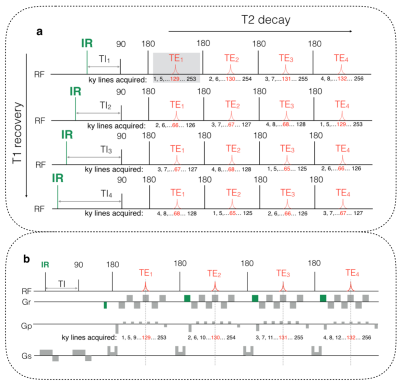 |
112 |
 Simultaneous T1 and T2 parametric mapping and synthetic MRI with IR-prepared echo-split gradient-echo and spin-echo imaging and parametric POCSMUSE reconstruction Simultaneous T1 and T2 parametric mapping and synthetic MRI with IR-prepared echo-split gradient-echo and spin-echo imaging and parametric POCSMUSE reconstruction
Mei-Lan Chu, Nan-kuei Chen
Our novel simultaneous T1 and T2 mapping framework, integrating IR-prepared echo-split GRASE acquisition and parametric POCSMUSE reconstruction, has the following advantages. First, T1 and T2 maps can be derived from four sets of single-shot IR-prepared echo-split GRASE data, with very high scan efficiency. Second, T1 and T2 relaxation time constants can be accurately measured by the parametric POCSMUSE algorithm, which models multiplexed signals across CPMG echoes and multiple IR-prepared data of multi-echo-pathway. Third, synthetic multi-contrast images can be generated from the measured parametric maps.
|
|
5644.
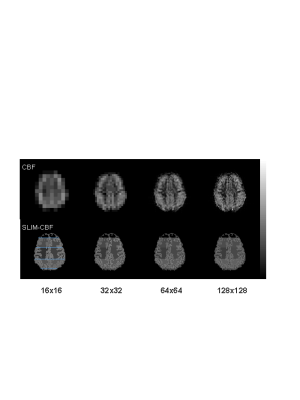 |
113 |
Improved quantification of cerebral blood flow in gray matter and white matter using non-Fourier based reconstruction
Video Permission Withheld
Phil Lee, Peter Adany, In-Young Choi
Accurate quantification of CBF in GM and WM is challenging due to intrinsically low SNR and low spatial resolution of CBF maps. In this study we propose a new approach in quantifying CBF in GM and WM, based on spectral localization by imaging (SLIM), which provides accurate CBF values in compartments with complex shapes, e.g., GM and WM by incorporating high-resolution anatomical information into CBF reconstruction at reduced scan time.
|
|
5645.
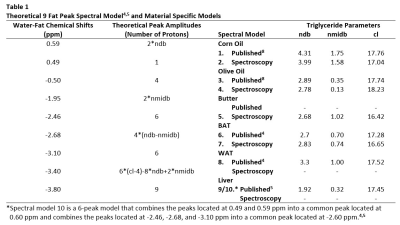 |
114 |
 Spectral Model Dependent Quantification of Triglyceride Composition using Chemical Shift Encoded Magnetic Resonance Imaging Spectral Model Dependent Quantification of Triglyceride Composition using Chemical Shift Encoded Magnetic Resonance Imaging
Gregory Simchick, Amelia Yin, Hang Yin, Qun Zhao
Dynamic processes such as brown adipose tissue (BAT) activation and white adipose tissue (WAT) beiging have been shown to change triglyceride composition. Therefore, accurate spatial quantification of triglyceride composition is important for the monitoring of these processes. Presented here is an evaluation of the performance of various fat spectral models on the quantification of triglyceride composition using chemical shift encoded magnetic resonance imaging (CSE-MRI). Variations as large as 45% and less than 2.82% are observed in the average estimations of triglyceride composition and proton density fat fraction (PDFF), respectively. Estimations obtained using a material specific model correlate better with spectroscopy estimations than other examined models.
|
|
5646.
 |
115 |
 An investigation into the effect of body composition on the agreement between whole-body fat mass determined by MRI and air-displacement plethysmography. An investigation into the effect of body composition on the agreement between whole-body fat mass determined by MRI and air-displacement plethysmography.
Andrew Weedall, Adrian Wilson, Sarah Wayte
The agreement between whole-body fat mass determined using MRI and air-displacement plethysmography (ADP) was investigated for a range of non-pathological body mass indexes (BMIs). The whole-body fat mass was determined for ten volunteers by two methods: firstly by ADP using a BODPOD®; and secondly using two different MRI sequences (LAVA-flex and IDEAL IQ). The whole-body fat mass determined by both MRI protocols showed good agreement with, but were consistently higher than, the ADP determination (mean difference: LAVA-flex=4±3kg; IDEAL IQ=2±3kg). In addition, analysis of Bland-Altman plots showed no change in the differences between the MRI and ADP fat mass with BMI.
|
|
5647.
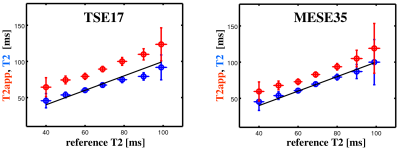 |
116 |
Linear B1-Dependent Correction of Quantitative in vivo T2 Maps Acquired with Fast Spin Echo Techniques
Video Permission Withheld
Ulrike Nöth, Manoj Shrestha, Jan-Rüdiger Schüre, Ralf Deichmann
A method is proposed for correcting the effects of stimulated echoes in T2 mapping based on fast spin echo sequences. In contrast to existing techniques, the proposed method does not require a priori knowledge of the radio frequency pulse profiles. A linear relationship between uncorrected apparent T2 (T2app) and corrected T2 values with B1-dependent regression parameters was found which facilitates the conversion of T2app into T2 maps. In vivo results show that corrected T2 values correspond closely to reference values and have an improved consistency across protocols.
|
|
5648.
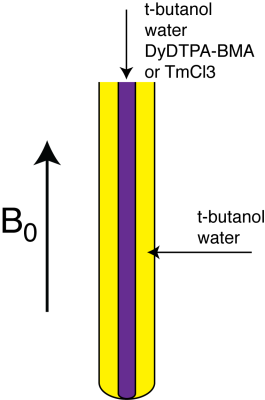 |
117 |
 MR Thermometry in Phantoms Using Bulk Magnetic Susceptibility MR Thermometry in Phantoms Using Bulk Magnetic Susceptibility
Scott Swanson, Dariya Malyarenko, Thomas Chenevert
We have developed a phantom for absolute temperature measurement based on the bulk magnetic susceptibility (BMS) of solutions of paramagnetic ions. This work shows that a solution of 150 mM dysprosium creates a BMS shift of approximately 0.09 ppm/°C.
|
|
5649.
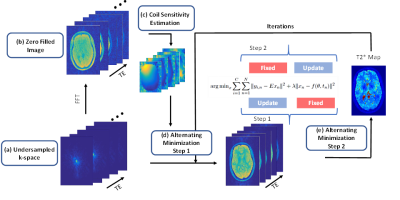 |
118 |
 Improved Accuracy of Accelerated 3D T2* Mapping with Coherent Parallel Maximum Likelihood Estimation Improved Accuracy of Accelerated 3D T2* Mapping with Coherent Parallel Maximum Likelihood Estimation
Wajiha Bano, Mohammad Golbabee, Arnold Benjamin, Ian Marshall, Michael Davies
We propose an approach that can reconstruct isotropic T2* Maps from undersampled data with improved accuracy by utilizing the phase information. Our approach extends the acceleration attained in Parallel Imaging(PI) to Maximum Likelihood Estimation (MLE) by imposing the exponential relaxation directly in the complex signal domain. The method was tested on a Multiecho Gradient Echo(MEGE) T2* mapping experiment in a numerical phantom and a human brain with realtime (prospective) undersampling. The approach showed that incorporating the phase information to perform coherent fitting resulted in better denoising and improved accuracy of the parametric maps.
|
|
5650.
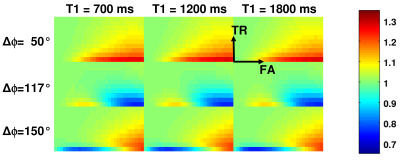 |
119 |
Correction for insufficient spoiling of transverse magnetization in T1 mapping based on the variable flip angle technique
Video Permission Withheld
Simon Baudrexel, Ulrike Noeth, Jan-Ruediger Schuere, Ralf Deichmann
A method is proposed for the correction of insufficient spoiling of transverse magnetization components in gradient echo data that are used for T1 quantification via the variable flip angle (VFA) approach. The method is based on the use of modified flip angles in the VFA algorithm that differ from the actual angles. The advantage is the versatility of the proposed method: from a given set of 21 values P(k,l), suitable correction parameters can be derived for any VFA protocol. In vitro and in vivo experiments show that this novel correction technique considerably increases the accuracy of measured T1 values.
|
|
5651.
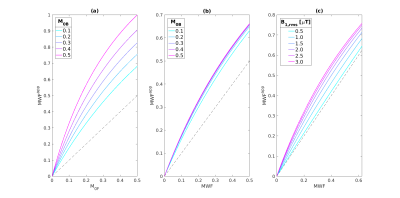 |
120 |
 Controlling magnetisation transfer and exchange effects in mcDESPOT relaxometry. Controlling magnetisation transfer and exchange effects in mcDESPOT relaxometry.
Daniel J. West, Rui Pedro A. G. Teixeira, Jacques-Donald Tournier, Joseph V. Hajnal, Shaihan J. Malik
Magnetisation transfer (MT) has been found to contribute to parameter estimation bias in sequences used in the two-pool relaxometry technique, mcDESPOT. Recent work shows that using controlled saturation magnetisation transfer (CSMT) RF-pulses, a two-pool system (free- and bound-pools) can behave as a single pool with modified equilibrium magnetisation and longitudinal relaxation rate. Here, we investigate the use of CSMT to model MT-effects in a three-pool system (exchange + MT) and show that under these conditions, signal behaves as a two-pool system and matches a mcDESPOT model but characterised by different parameters than those originally assumed.
|
|

























